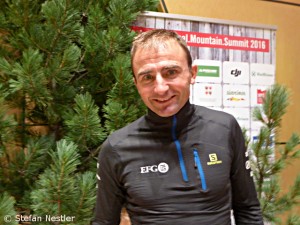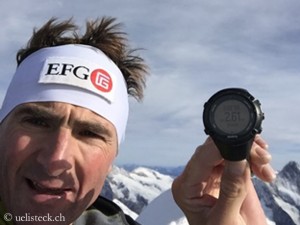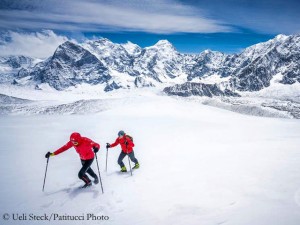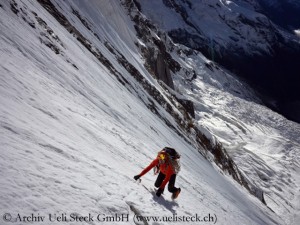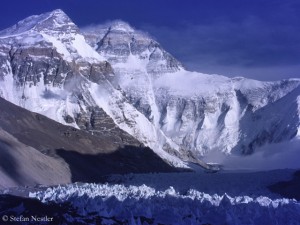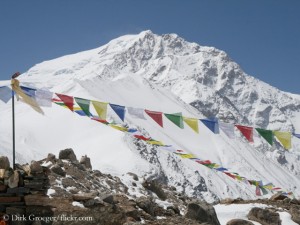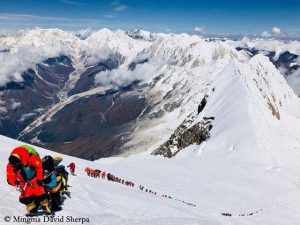Ueli Steck: “If you go too far, you are dead”
If “The Fast and the Furious” had been a film about climbers, Ueli Steck could have played the leading role. The Swiss is just extremely fast. The Eiger North Face in two hours and 22 minutes, the 82 four-thousanders of the Alps within 61 days, solo via the Annapurna South Face to the 8091-meter-high summit and back in 28 hours, through Shishapangma South Face within ten and a half hours – for good reason Ueli is nicknamed “The Swiss Machine”. As if he had a tuned engine inside like the cars in “The Fast and the Furious”. Just recently, Steck has returned from India. I met him at the International Mountain Summit (IMS) in Bressanone in South Tyrol and talked to him about his tendency to speed, about aging and his next plans.
Ueli, you just turned 40 years old and you were not at home. How did you spend your birthday?
I was climbing along with my wife on Shivling in India (a 6,543 meter-high extremely shapely and challenging mountain in the north of the country). It was a very nice trip and a proper celebration of my 40th birthday.
And you have given yourself a summit success?
Yes, we had great weather. Within seven days we were standing on top of Shivling. It was perfect.
There has just been a mountain drama on Shivling: Two Polish mountaineers died.
When I went to Bressanone today, my Indian liasion officer sent me the bad news via Whatsapp. I just thought: Not again! We were together in base camp, really nice guys. It’s just sad. You always ask yourself: Why? Greg (Grzegorz Kukurowski) died because he suffered from high altitude sickness. You think that is not necessary anymore. Why does this happen again and again? I find it sad, on the other hand it annoys me.
Back to you. Aged 40, other people are getting slower. But I feel like you’re getting even faster.
At the moment it is still going uphill. (He laughs) You have to accept your age and not be sad that it is not like it was 15 years ago. I need a bit more rest, more time for recovery. But you can also see it positively: I have now more time to sit on the sofa. I think, age is just a matter of attitude.
You’ve always been fast on the road, but I feel like you’ve discovered speed in a new way.
I‘ve optimized it a bit and targeted my training on it. I know I can still put some peaks for the next four, five years.
Last spring, when you were trying to climb Shishapangma South Face via a new route along with German David Goettler, you both always seemed to be running fast. First you did it like crazy to acclimatize, and then you continued to run via the South Face.
We were always on the road. This is what I like. We said from the beginning: We want to climb and not to sit in Base Camp doing nothing. We wanted to move and have fun. And we succeeded in doing this.
You have carried equipment during your climb. Fast and light, this makes you more vulnerable.
You have to be careful. We were already on the summit plateau, bad weather was coming from behind, but there was still blue sky in the front. Then you can go ahead. But you know you have no margin. If you push forward and climb to the top, and then the storm comes and you have to bivouac, you are dead. Because you haven’t any suitable equipment. So you just have to be careful.
This is a topic that is on my mind. At the moment there is a trend to run with sneakers from the valley to the summit of Mont Blanc. People see it and think it always works. But you cannot go up there every day with sneakers. I think we need to sensitize people to this problem. When is it possible, when not, and when do you better turn around?
You have to be careful when climbing. It has now taken me and my wife seven days to climb Shivling. This is possible, but of course you are not fully acclimatized. You have to be aware that if you have headache and it’s getting worse, you have to go down. And if you do not, someone dies. You can be fast, light and efficient, but you have to be aware of the risks and dangers.
Do you benefit from your great experience as an extreme climber, who has, after all, been able to celebrate his 40th birthday?
Logically, and I can play that out. Especially when I climb in high altitude. I have done so many expeditions, I know exactly where I am, what I have to do and how much I can push. But you also have to be able to turn around. There was no endless discussion on Shishapangma between David and me. We both have a lot of experience and know what it means if you go too far. Then you will not come back one day. If you have experienced so many times climbers dying, you are much more conscious of this than someone who does it for the first time and says: “It’s snowing, well. We’ll go on, we’re not softies!”
Will you now travel more frequently with your wife to the Himalayas?
We have already made a lot of nice expeditions together. Nobody knows that. We are on holiday. And our agreement is that I don’t make it public. We will continue to go together on expedition. As long as possible.
Are you telling me your next project?
I want to try again the Everest-Lhotse traverse.
I certainly don’t need to ask whether with or without bottled oxygen.
The project is not interesting with bottled oxygen at all.
Will you do it alone or with a partner?
The idea is to climb with Tenji Sherpa as a team of two. (He joined Steck during his climb of Everest without breathing mask in 2012. Tenji also accompanied Ueli in later expeditions in Nepal.)
Will you try to be successful early in the season to avoid the crowds on the route?
I am relatively relaxed. If you are a climber, you can also go up off the trail. Even at Hillary Step you can turn right if you want. I will not let me put under stress.



